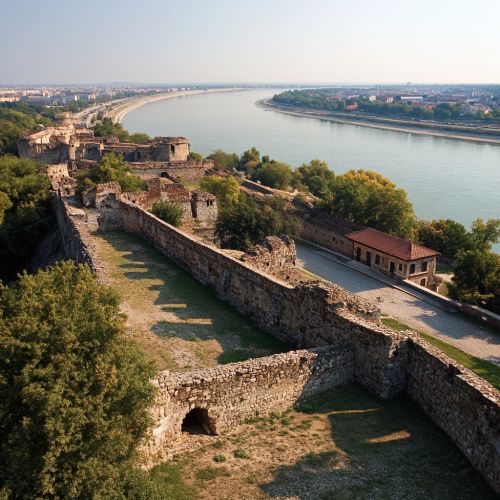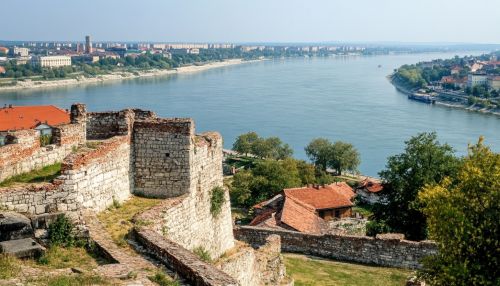Smederevo
History
Smederevo is a city located in Serbia, situated on the right bank of the Danube River. The city's history is rich and multifaceted, dating back to ancient times. Smederevo was founded in the early 15th century by Serbian Despot Đurađ Branković as the new capital of the Serbian Despotate. The city was strategically positioned to serve as a fortress and a stronghold against the Ottoman Empire.
The construction of the Smederevo Fortress began in 1428 and was completed in 1430. The fortress is one of the largest medieval fortifications in Europe, covering an area of approximately 11 hectares. It was designed to protect the city from invasions and played a crucial role in the defense of the Serbian Despotate.
In 1459, Smederevo fell to the Ottomans, marking the end of the Serbian Despotate. The city remained under Ottoman rule for several centuries, during which time it served as an important administrative and military center. The Ottomans made several modifications to the fortress, enhancing its defensive capabilities.
During the Austro-Turkish War (1716-1718), Smederevo was briefly occupied by the Habsburg Monarchy. However, it was returned to Ottoman control following the Treaty of Passarowitz in 1718. The city continued to be a significant military outpost for the Ottomans until the early 19th century.
In 1805, during the First Serbian Uprising, Smederevo was liberated from Ottoman rule by Serbian revolutionary forces led by Karađorđe Petrović. The city became an important center of the newly established Serbian state. However, it was recaptured by the Ottomans in 1813 and remained under their control until the Second Serbian Uprising in 1815, which ultimately led to the establishment of the autonomous Principality of Serbia.
Geography
Smederevo is located in the central part of Serbia, approximately 45 kilometers southeast of the capital city, Belgrade. The city lies on the right bank of the Danube River, which is the second-longest river in Europe. The geographical coordinates of Smederevo are 44.67° N latitude and 20.93° E longitude.
The terrain around Smederevo is predominantly flat, with some rolling hills to the south and west. The climate in Smederevo is classified as humid continental, characterized by hot summers and cold winters. The average annual temperature is around 12°C, with January being the coldest month and July the warmest.
The Danube River plays a significant role in the city's geography and economy. It serves as a major transportation route, facilitating trade and commerce. The river also provides opportunities for fishing, tourism, and recreational activities.
Economy
Smederevo's economy has traditionally been based on agriculture, industry, and trade. The fertile plains surrounding the city are well-suited for the cultivation of various crops, including wheat, corn, and sunflowers. Viticulture is also an important agricultural activity, with the region being known for its high-quality wines.
The industrial sector in Smederevo is diverse, with significant contributions from the steel industry, manufacturing, and food processing. The Smederevo Steel Plant, also known as Železara Smederevo, is one of the largest industrial enterprises in the city. It has a long history of steel production and has undergone several ownership changes over the years.
Trade and commerce are facilitated by Smederevo's strategic location along the Danube River and its proximity to major transportation routes. The city has a well-developed infrastructure, including road, rail, and river transport networks.
Culture
Smederevo has a rich cultural heritage, with numerous historical and cultural landmarks. The Smederevo Fortress is the most prominent historical site in the city. It is a well-preserved medieval fortress that attracts tourists and history enthusiasts from around the world. The fortress hosts various cultural events, including the annual Smederevo Autumn Festival, which celebrates the city's wine-making tradition.
The city is also home to several museums, galleries, and cultural institutions. The Smederevo Museum houses a collection of artifacts and exhibits related to the city's history and cultural heritage. The National Library of Smederevo is an important cultural institution that provides access to a wide range of books, periodicals, and other resources.
Smederevo has a vibrant arts scene, with numerous theaters, music ensembles, and art galleries. The city hosts various cultural events and festivals throughout the year, including the Smederevo Poetry Festival and the International Film Festival.
Education
Smederevo has a well-developed education system, with numerous primary and secondary schools, as well as higher education institutions. The city is home to several high schools that offer specialized programs in various fields, including science, technology, and the arts.
The University of Belgrade has a branch in Smederevo, offering undergraduate and graduate programs in various disciplines. The presence of higher education institutions contributes to the city's intellectual and cultural life, attracting students and academics from across the region.
Transportation
Smederevo is well-connected to other parts of Serbia and neighboring countries through a network of roads, railways, and river transport routes. The city is located along the E75 European route, which connects it to Belgrade and other major cities in Serbia.
The Smederevo Port on the Danube River is an important transportation hub, facilitating the movement of goods and passengers. The port is equipped with modern facilities and handles a significant volume of cargo traffic.
The city is also served by a railway station, providing connections to Belgrade and other destinations. Public transportation within Smederevo includes buses and taxis, offering convenient options for local travel.
Demographics
As of the latest census, Smederevo has a population of approximately 64,000 residents. The city is ethnically diverse, with a majority of Serbs, followed by smaller communities of Roma, Hungarians, and other ethnic groups. The official language is Serbian, and the majority of the population adheres to the Serbian Orthodox Church.
The demographic profile of Smederevo reflects a mix of urban and rural characteristics, with a significant portion of the population engaged in agriculture and industrial activities. The city has experienced population growth in recent years, driven by economic development and improved living standards.
Notable Landmarks
Smederevo is home to several notable landmarks that reflect its rich history and cultural heritage. The Smederevo Fortress is the most iconic landmark, known for its impressive architecture and historical significance. The fortress is a popular tourist destination and a symbol of the city's medieval past.
Other notable landmarks include the Church of St. George, a Serbian Orthodox church built in the 19th century, and the Main Square, which serves as the city's central gathering place. The Smederevo Museum and the National Library of Smederevo are also important cultural institutions that preserve and promote the city's heritage.
See Also
- Serbian Despotate
- Danube River
- Ottoman Empire
- Austro-Turkish War
- First Serbian Uprising
- Principality of Serbia


References
- Popović, M. (2000). "The History of Smederevo." Belgrade: Serbian Academy of Sciences and Arts.
- Jovanović, D. (2015). "Smederevo: A Cultural and Historical Overview." Novi Sad: Matica Srpska.
- Petrović, V. (2018). "The Strategic Importance of Smederevo in Medieval Serbia." Journal of Balkan Studies, 12(3), 45-67.
